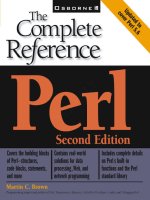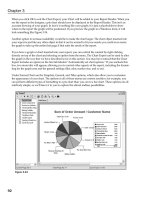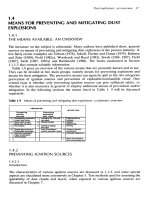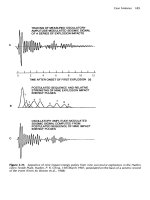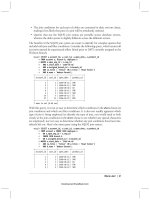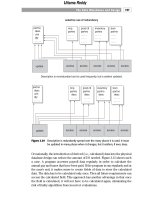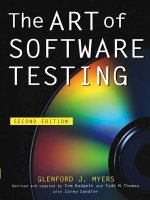perl the complete reference second edition phần 4 pdf
Bạn đang xem bản rút gọn của tài liệu. Xem và tải ngay bản đầy đủ của tài liệu tại đây (845.6 KB, 125 trang )
my $owner = getpwuid($userid);
$owner = $userid unless (defined($owner));
return $owner;
}
The return value from this method is the user name or user ID. Because of this, you
have no way of raising an error exception to the calling script, so you have to use croak
to indicate a serious problem when determining the owner of the file.
STORE THIS, VALUE
The STORE method is called whenever an assignation is made to the tied variable.
Beyond the object reference that is passed, tie also passes the value you want stored in
the scalar variable you are tied to.
sub STORE
{
my $self = shift;
my $owner = shift;
confess("Wrong type") unless ref $self;
croak("Too many arguments") if @_;
my $userid;
if ($owner =~ /$[a-zA-Z]+/)
{
$userid = getpwnam($owner)
}
else
{
$userid = $owner;
}
local $! = 0;
chown($userid,$$self);
if ($!) { croak("Can't set file ownership: $!") }
return $owner;
}
Chapter 10: Complex Data Structures
335
PROGRAMMING
WITH PERL
336
Perl: The Complete Reference
The only thing of note here is that you return the new assigned value, since that’s
the return value of any other assignment.
DESTROY THIS
The DESTROY method is called when the associated object is disassociated,
either because it’s gone out of scope, or when untie is called. Generally, this method
shouldn’t be used, since Perl will do its own deallocation and garbage collection.
However, as mentioned earlier, this method can be used when you want to close
opened files, disconnect from servers cleanly, and so on. In the realms of a scalar,
this is seldom required.
Tying Arrays
Classes for tying arrays must define at least three methods: TIEARRAY, FETCH, and
STORE. You may also want and/or need to define the DESTROY method. At the present
time, the methods for tied arrays do not cover some of the functions and operators
available to untied arrays. In particular, there are no equivalent methods for the $#array
operator, nor for the push, pop, shift, unshift, or splice functions.
Since you already know the basics surrounding the creation of tied objects, we’ll
dispense with the examples and cover the details of the methods required to tie arrays.
TIEARRAY CLASSNAME, LIST
This method is called when the tie function is used to associate an array. It is the
constructor for the array object and, as such, accepts the class name and should return
an object reference. The method can also accept additional arguments, used as required.
See the TIESCALAR method in the “Tying Scalars” section earlier.
FETCH THIS, INDEX
This method will be called each time an array element is accessed. The INDEX
argument is the element number within the array that should be returned.
STORE THIS, INDEX, VALUE
Chapter 10: Complex Data Structures
337
PROGRAMMING
WITH PERL
This method is called each time an array element is assigned a value. The INDEX
argument specifies the element within the array that should be assigned, and VALUE
is the corresponding value to be assigned.
DESTROY THIS
This method is called when the tied object needs to be deallocated.
Tying Hashes
Hashes are the obvious (and most complete) of the supported tie implementations.
This is because the tie system was developed to provide more convenient access to
DBM files, which themselves operate just like hashes.
TIEHASH CLASSNAME, LIST
This is the class constructor. It needs to return a blessed reference pointing to the
corresponding object.
FETCH THIS, KEY
This returns the value stored in the corresponding KEY and is called each time a single
element of a hash is accessed.
STORE THIS, KEY, VALUE
This method is called when an individual element is assigned a new value.
DELETE THIS, KEY
This method removes the key and corresponding value from the hash. This is usually
the result of a call to the delete function.
CLEAR THIS
This empties the entire contents of the hash.
EXISTS THIS, KEY
This is the method called when exists is used to determine the existence of a particular
key in a hash.
FIRSTKEY THIS
This is the method triggered when you first start iterating through a hash with each,
keys, or values. Note that you must reset the internal state of the hash to ensure that
the iterator used to step over individual elements of the hash is reset.
NEXTKEY THIS, LASTKEY
This method is triggered by a keys or each function. This method should return two
values—the next key and corresponding value from the hash object. The LASTKEY
argument is supplied by tie and indicates the last key that was accessed.
DESTROY THIS
This is the method triggered when a tied hash’s object is about to be deallocated.
338
Perl: The Complete Reference
Chapter 11
System Information
339
Copyright 2001 The McGraw-Hill Companies, Inc. Click Here for Terms of Use.
T
here are times when what you need to do is communicate with the host operating
system. This can be done at a number of different levels, but there are two core
elements that Perl provides built-in support for. The first is the user and group
system employed by Unix. The user and group functions are built into Perl, and this is
just one of the places where Perl shows its Unix heritage.
The other, more practical, set of functions relates to getting the current time from
the system and converting that time into a format that can be used effectively. Once
you’ve got the information, you’ll probably want to play with it too, so I’ve also
included information on how to manipulate time values.
Finally, we’ll also take this opportunity to look at the generic environment variables
available to Perl, how they affect Perl’s operation, as well as information on how to
determine the information by other means.
Users and Groups
For most situations, the built-in variables initialized at execution time provide the basic
user and group information for the current script. To recap, the relevant variables are
summarized in Table 11-1. Note that all of this information and the functions in this
chapter are only really relevant on a Unix machine. Neither Mac OS nor Windows has
the same facilities. However, under Windows you can use the Win32::AdminMisc or
340
Perl: The Complete Reference
Variable Description
$< The real user ID (uid) of the current process. This is the user ID of the
user who executed the process, even if running setuid.
$> The effective user ID (uid) of the current process. This is the user ID
of the current process and defines what directories and features are
available.
$( The real group ID (gid) of the current process contains a space-separated
list of the groups you are currently in if your machine supports
multiple group membership. Note that the information is listed in
group IDs, not names.
$) The effective group ID (gid) of the current process contains a
space-separated list of the groups you are currently in if your machine
supports multiple group membership. Note that the information is
listed in group IDs, not names.
Table 11-1.
Perl Variables Containing Group and User Membership
TEAMFLY
Team-Fly
®
Chapter 11: System Information
341
PROGRAMMING
WITH PERL
Win32::NetAdmin modules to determine the same information. See Appendix B for
more information on the Win32::NetAdmin module, and Web Appendix B at
www.osborne.com for a list of other Win32 modules.
The most basic function for determining your current user name is the getlogin
function, which returns the current user name (not uid) of the current process.
getlogin
Getting Unix Password Entries
The next two functions, getpwuid and getpwnam, return, in a list context, the user
information as a list of scalar values. The getpwuid function gets the information based
on the user’s supplied ID number, and getpwnam uses the supplied name. These
provide an interface to the equivalent system functions, which just return the
information stored in the /etc/passwd file (on a Unix system).
getpwuid EXPR
getpwnam EXPR
This returns the following:
($name,$passwd,$uid,$gid,$quota,$comment,$gcos,$dir,$shell)
= getpwnam('MC');
In a scalar context, each function returns the most useful value. That is, getpwuid
returns the user name, while getpwnam returns the user ID. The details of the contents
of each element are summarized in Table 11-2. Note that names are advisory; you can
assign the details to any scalar.
By using these functions, you can easily print the user name by getting the user’s ID
from the built-in $< variable:
print "Apparently, you are: ",(getpwuid($<))[0],"\n";
As another example, you can obtain the user name for the current user by using
$name = getlogin || (getpwuid($<))[0] || 'Anonymous';
To read the entire contents of the /etc/passwd file, you could read and process
the individual lines yourself. An easier method, however, is to use the getpwent
function set:
getpwent
setpwent
endpwent
The first call to getpwent returns the user information (as returned by getpwnam) for
the first entry in the /etc/passwd file. Subsequent calls return the next entry, so you
can read and print the entire details using a simple loop:
while(($name,$dir)=(getpwent)[0,7])
{
print "Home for $name is $dir\n";
}
342
Perl: The Complete Reference
Element Name Description
0 $name The user’s login name.
1 $passwd The user’s password in its encrypted form. See
“Password Encryption” later in this chapter for more
details on using this element.
2 $uid The numerical user ID.
3 $gid The numerical primary group ID.
4 $quota The user’s disk storage limit, in kilobytes.
5 $comment The contents of the comment field (usually the full name).
6 $gcos The user’s name, phone number, and other information.
This is only supported on some Unix variants. Don’t rely
on this to return a useful name; use the $comment field
instead.
7 $dir The user’s home directory.
8 $shell The user’s default login shell interpreter.
Table 11-2.
Information Returned by getpwent, getpwnam, and getpwuid
In a scalar context, the getpwent function only returns the user name. A call to
setpwent resets the pointer for the getpwent function to the start of the /etc/passwd
entries. A call to endpwent indicates to the system that you have finished reading
the entries, although it performs no other function. Neither setpwent nor endpwent
return anything.
Getting Unix Group Entries
Along with the password entries, you can also obtain information about the groups
available on the system:
getgrgid EXPR
getgrnam EXPR
In a scalar context, you can therefore obtain the current group name by using
$group = getgrgid($();
or if you are really paranoid, you might try this:
print "Bad group information" unless(getgrnam(getgrgid($()) == $();
The getgrgid and getgrnam functions operate the same as the password equivalents,
and both return the same list information from the /etc/group or equivalent file:
($name,$passwd,$gid,$members) = getgruid($();
The $members variable will then contain a space-separated list of users who are
members of the group $name. The elements and their contents are summarized in
Table 11-3.
There is also a getgrent function set for reading the entire group information
in a loop:
while(($name,$members)=(getgrent)[0,3])
{
print "$name has these members: $members\n";
}
Like the equivalent password functions, setgrent resets the pointer to the beginning
of the group file, and endgrent indicates that you have finished reading the group file.
Chapter 11: System Information
343
PROGRAMMING
WITH PERL
Password Encryption
All passwords on Unix are encrypted using a standard system function called crypt().
This uses an algorithm that is one-way—the idea being that the time taken to decode
the encrypted text would take more processing power than is available in even the
fastest computer currently available. This complicates matters if you want to compare
a password against the recorded password. The operation for password checking is
to encrypt the user-supplied password and then compare the encrypted versions
with each other. This negates the need to even attempt decrypting the password.
The Perl encryption function is also crypt, and it follows the same rules. There are
two arguments—the string you want to encrypt and a “salt” value. The salt value is
an arbitrary string used to select one of 256 different combinations available for the
encryption algorithm on the specified string. Although the rules say the size of the salt
string should be a maximum of two characters, there is no need to reduce the string
used, and the effects of the salt value are negligible. In most situations you can use
any two-character (or more) string.
For example, to compare a supplied password with the system version:
$realpass = (getpwuid($<))[1];
die "Invalid Password" unless(crypt($pass,$realpass) eq $realpass);
The fact that the password cannot be cracked means the encryption system is useless
for encrypting documents. For that process, it is easier to use one of the many
encryption systems available via CPAN.
344
Perl: The Complete Reference
Element Name Description
0 $name The group name.
1 $passwd The password for gaining membership to the group.
This is often ignored. The password is encrypted using
the same technique as the login password information.
See “Password Encryption” for more details.
2 $gid The numerical group ID.
3 $members A space-separated list of the user names (not IDs) that
are members of this group.
Table 11-3.
Elements Returned by the getgrent, getgrnam, and getgrgid Functions
Chapter 11: System Information
345
PROGRAMMING
WITH PERL
Time
Date and time calculations are based around the standard epoch time value. This is
the number of seconds that have elapsed since a specific date and time: 00:00:00 UTC,
January 1, 1970 for most systems; 00:00:00, January 1, 1904 for Mac OS. The maximum
time that can be expressed in this way is based on the maximum value for an unsigned
integer, 2
31
–1, which equates to Tue Jan 19 03:14:07 2038.
Although it’s a moot point now (I’m writing this in November 2000), Perl was
completely Y2K compliant. However, due to the way in which Perl returns the year
information, there were a number of problems with scripts returning “19100” on 1
st
Jan because people added the string “19” to the start of the date, not the integer 1900.
gmtime and localtime
To obtain the individual values that make up the date and time for a specific epoch
value, you use the gmtime and localtime functions. The difference between the two is
that gmtime returns the time calculated against the GMT or UTC time zones, irrespective
of your current locale and time zone. The localtime function returns the time using the
modifier of the current time zone.
localtime EXPR
localtime
In a list context, both functions convert a time specified as the number of seconds
since the epoch. The time value is specified by EXPR or is taken from the return value
of the time function if EXPR is not specified. Both functions return the same
nine-element array:
# 0 1 2 3 4 5 6 7 8
($sec,$min,$hour,$mday,$mon,$year,$wday,$yday,$isdst) = localtime(time);
The information is derived from the system struct tm time structure, which has a few
traps. The ranges for the individual elements in the structure are shown in Table 11-4.
Since the value returned is a list, you can use subscript notation to extract
individual elements from the function without having to create useless temporary
variables. For example, to print the current day, you might use
print (qw(Sun Mon Tue Wed Thu Fri Sat Sun))[(localtime)][6];
In a scalar context, this returns a string representation of the time specified by EXPR,
roughly equivalent to the value returned by the standard C ctime() function:
$ perl -e 'print scalar localtime,"\n";'
Sat Feb 20 10:00:40 1999
The Perl module Time::Local, which is part of the standard distribution, can create
an epoch value based on individual values (effectively the opposite of localtime):
$time = timelocal($sec,$min,$hours,$mday,$mon,$year);
In most situations, you should use localtime over gmtime, since localtime probably
returns what you want. The only time to use the gmtime function is in a situation
where a naturalized time is required for comparison purposes across time zones.
346
Perl: The Complete Reference
Element Range Notes
$sec 0–59 Seconds
$min 0–59 Minutes
$hour 0–23 Hours
$mday 1–31 Day of the Month
$mon 0–11 This has the benefit that an array can be defined directly,
without inserting a junk value at the start. It’s also
incompatible with the format in which dates may be
supplied back from the user.
$year 0– All years on all platforms are defined as the number of
years since 1900, not simply as a two-digit year. To get
the full four-digit year, add 1900 to the value returned.
$wday 0–6 This is the current day of the week, starting with Sunday.
$yday 0–366
$isdst 0–1 Returns true if the current locale is operating in daylight
saving time.
Table 11-4.
Ranges for the gmtime and localtime Functions
time Function
The time function returns the number of seconds since the epoch. You use this value to
feed the input of gmtime and localtime, although both actually use the value of this
function by default.
time
In addition, since it returns a simple integer value, you can use the value returned
as a crude counter for timing executions:
$starttime=time;
for (1 100000)
{
log(abs(sin($_)))*exp(sin($_));
}
$endtime=time;
print "Did 100,000 calculations in ",$endtime-$starttime, "seconds\n";
The granularity here is not good enough for performing real benchmarks. For that,
either use the times function, discussed later, or the Benchmark module, which in fact
uses the times function.
Comparing Time Values
When comparing two different time values, it is easier to compare epoch calculated times
(that is, the time values in seconds) and then extract the information accordingly. For
example, to calculate the number of days, hours, minutes, and seconds between dates:
($secdiff,$mindiff,$hourdiff,$ydaydiff)
= (gmtime($newtime-$oldtime))[0 2,7]
The $secdiff and other variables now contain the corresponding time-value differences
between $newtime and $oldtime.
You should use gmtime not localtime when comparing time values. This is because
localtime takes into account the local time zone, and, depending on the operating
system you are using, any daylight saving time (DST) too. The gmtime function will
always return the Greenwich Mean Time (GMT), which is not affected by time zones
or DST effects.
Chapter 11: System Information
347
PROGRAMMING
WITH PERL
Converting Dates and Times into Epochs
There is no built-in function for converting the value returned by localtime or gmtime
back into an epoch equivalent, but you can use the Time::Local module, which supplies
the timegm and timelocal functions to do the job for you. For example, the script:
use Time::Local;
$time = time();
($sec,$min,$hour,$mday,$mon,$year) = (localtime($time))[0 5];
$newtime = timelocal($sec,$min,$hour,$mday,$mon,$year);
print "Supplied $time, returned $newtime\n";
should return identical values.
Time Arithmetic
There are a number of ways in which you can modify a given time when it’s expressed
as an epoch value. For example, imagine that you want to determine what the date will
be in seven days time. You could use:
($mday,$mon,$year) = (localtime($time))[3 5];
$mday += 7;
$mon++;
$year+=1900;
print "Date will be $mday/$mon/$year\n";
However, this isn’t really very useful, since it doesn’t take into account that adding
seven to the current day of the month could put us into the next month, or possibly
even into the next year. Instead, you should add seven days to the value that you
supply to the localtime function. For example:
($mday,$mon,$year) = (localtime($time+(7*24*60*60)))[3 5];
$mon++;
$year+=1900;
print "Date will be $mday/$mon/$year\n";
Here, we’ve added seven days (7 times 24 hours, times 60 minutes, times 60
seconds); because we’re asking localtime to do the calculation on the raw value we’ll
get the correct date. You can do similar calculations for other values too, for example:
$time -= 7*24*60*60; # Last week
$time += 3*60*60; # Three hours from now
348
Perl: The Complete Reference
$time -= 24*60*60; # This time yesterday
$time += 45*60; # Three quarters of an hour from now
The limitation of this system is that it only really works on days, hours, minutes,
and seconds. The moment you want to add months or years, the process gets more
complicated, as you would need to determine how many days in the month or year
in order to get the correct epoch value.
To resolve both problems, you might consider using a function like the one below,
which will add or subtract any time value to any other time value. It’s based on the
Visual Basic DateAdd function:
use Time::Local;
sub DateAdd
{
my ($interval, $number, $time, $sec,
$min, $hour, $mday, $mon, $year);
if (@_ <= 3)
{
if (@_ == 2)
{
$time = time();
($interval, $number) = @_;
}
else
{
($interval, $number, $time) = @_;
}
($sec,$min,$hour,$mday,$mon,$year)
= (localtime($time))[0 5];
}
else
{
($interval, $number, $time, $sec,
$min, $hour, $mday, $mon, $year) = @_;
}
$year += $number if ($interval eq 'yyyy');
if (($interval eq 'q') || ($interval eq 'm'))
{
Chapter 11: System Information
349
PROGRAMMING
WITH PERL
350
Perl: The Complete Reference
$mon += $number if ($interval eq 'm');
$mon += ($number*3) if ($interval eq 'q');
if ($mon > 11)
{
$year += int ($mon/12);
$mon = $mon % 12;
}
}
$newtime = timelocal($sec,$min,$hour,$mday,$mon,$year);
$newtime += ($number*24*60*60) if (($interval eq 'y') ||
($interval eq 'd') ||
($interval eq 'w'));
$newtime += ($number*7*24*60*60) if ($interval eq 'ww');
$newtime += ($number*60*60) if ($interval eq 'h');
$newtime += ($number*60) if ($interval eq 'n');
$newtime += $number if ($interval eq 's');
return $newtime;
}
To use this function, supply the interval type (as shown in Table 11-5) and the
number to be added. If you don’t supply a time value, then the current time will be
used. Alternatively, you can supply either an epoch value or the seconds, minutes,
hours, day of the month, month, and year, in the same format as that returned
by localtime.
For example, the following adds three weeks to the current date (1
st
April), and then
outputs a date/time string of the new value:
print scalar localtime(DateAdd('ww',3)),"\n";
generates
Sat Apr 22 13:50:51 2000
TEAMFLY
Team-Fly
®
Chapter 11: System Information
351
PROGRAMMING
WITH PERL
times Function
The times function
times
returns a four-element list giving the CPU time used by the current process for
user-derived and system-derived tasks, and the time used by any children for user-
and system-derived tasks:
($user, $system, $child, $childsystem) = times;
The information is obtained from the system times() function, which reports the
time in seconds to a granularity of a hundredth of a second. This affords better timing
Interval Description
yyyy Year
q Quarter
m Month
y Day of year
d Day
w Weekday
ww Week
h Hour
n Minute
s Second
Table 11-5.
Interval Conversions
options than the time command, although the values are still well below the normal
microsecond timing often required for benchmarking. That said, for quick comparisons
of different methods, assuming you have a suitable number of iterations, both the
time and times functions should give you an idea of how efficient, or otherwise,
the techniques are.
Here’s the benchmark example (seen in the “time Function” section earlier in this
chapter), using times:
$starttime=(times)[0];
for (1 100000)
{
log(abs(sin($_)))*exp(sin($_));
}
$endtime=(times)[0];
print "Did 100,000 calculations in ",$endtime-$starttime, "seconds\n";
sleep Function
You can pause the execution of a script by using the sleep function.
sleep EXPR
sleep
The function sleeps for EXPR seconds, or for the value in $_ if EXPR is not specified.
The function can be interrupted by an alarm signal (see “Alarms,” next). The
granularity of the functions is always by the second, and the accuracy of the function
is entirely dependent on your system’s sleep function. Many may calculate the end
time as the specified number of seconds from when it was called. Alternatively, it may
just add EXPR seconds to the current time and drop out of the loop when that value
is reached. If the calculation is made at the end of the second, the actual time could
be anything up to a second out, either way.
If you want a finer resolution for the sleep function, you can use the select function
with undefined bitsets, which will cause select to pause for the specified number of
seconds. The granularity of the select call is hundredths of a second, so the call
select(undef, undef, undef, 2.35);
will wait for 2.35 seconds. Because of the way the count is accumulated, the actual
time waited will be more precise than that achievable by sleep, but it’s still prone to
similar problems.
352
Perl: The Complete Reference
PROGRAMMING
WITH PERL
Chapter 11: System Information
353
Alarms
By using signals, you can set an alarm. This is another form of timer that waits for a
specified number of seconds while allowing the rest of the Perl script to continue. Once
the time has elapsed, the SIGALRM signal is sent to the Perl script, and if a handler
has been configured, the specified function will execute. This is often used in situations
where you want to provide a time-out for a particular task. For example, here’s a user
query with a default value—if the user does not respond after 10 seconds, the script
continues with the default value:
print "What is your name [Anonymous]?\n";
eval
{
local $SIG{ALRM} = sub { die "Timeout" };
alarm 10;
chomp($answer = <STDIN>);
alarm 0;
};
if ($@ and $@ =~ /Timeout/)
{
$answer = "Anonymous";
}
print "Hello $answer!\n";
The eval block is required so that the die statement that forms the signal handler
drops out of the eval— setting the value of $@—rather than terminating the whole
script. You can then test that and decide how to proceed. Of course, if the user provides
some input; then the alarm is reset to zero, disabling the alarm timer and allowing you
to drop out of the eval block normally.
We’ll be looking in more detail at signals and signal handlers in Chapter 14, and
at the use of the eval function in Chapter 15.
Environment Variables
As we saw in Chapter 4, Perl provides an interface to the environment variables of the
current Perl interpreter using the %ENV built-in variable. For example, to access the
PATH value, you would use the following:
print $ENV{PATH};
The environment can affect the operation of different systems in subtle ways. The
PATH environment variable, for example, contains the list of directories to be searched
when executing an external program through exec, system, or backticks.
As a general rule, it’s not a good idea to always rely on the values defined in the
environment variables, because they are largely arbitrary. In Tables 11-6 and 11-7, I’ve
listed the environment variables that you are likely to come across under Unix-based
and Windows-based operating systems, respectively.
Where relevant, the tables show a probable default value that you can use. The
tables also list alternative locations where you can find the same information without
relying on an environment variable. Mac OS (but not Mac OS X, which is Unix based)
and other non-interactive platforms don’t rely so heavily on environment variables for
the execution of scripts anyway.
354
Perl: The Complete Reference
Variable Description Alternatives
COLUMNS The number of columns for the current display.
Can be useful for determining the current
terminal size when developing a terminal/text
interface. However, it’s probably better to rely
on a user setting or just use the Term::*
modules and let them handle the effects. If you
do need a base value, then use vt100, which
most terminal emulators support.
None
EDITOR The user’s editor preference. If it can’t be
found, then default to vi or emacs or, on
Windows, to C:/Windows/Notepad.exe.
None
EUID The effective user ID of the current process.
Use $>, which will be populated correctly by
Perl, even when using suidperl.
$>
HOME The user’s home directory. Try getting the
information from getpwuid instead.
getpwuid
HOST The current hostname. The hostname.pl script
included with the standard Perl library
provides a platform-neutral way of
determining the hostname.
hostname.pl
HOSTNAME The current hostname. hostname.pl
Table 11-6.
Environment Variables on Unix Machines
Chapter 11: System Information
355
PROGRAMMING
WITH PERL
Variable Description Alternatives
LINES The number of lines supported by the current
terminal window or display. See COLUMNS
earlier in the table.
None
LOGNAME The user’s login. Use the getlogin function or,
better still, the getpwuid function with the $<
variable.
getlogin,
getpwuid($<)
MAIL The path to the user’s mail file. If it can’t be
found, try guessing the value; it’s probably
/var/mail/LOGNAME or
/var/spool/mail/LOGNAME.
None
PATH The colon-separated list of directories to search
when looking for applications to execute. Aside
from the security risk of using an external list,
you should probably be using the full path to
the applications that you want to execute, or
populating PATH within your script.
None
PPID The parent process ID. There’s no easy way to
find this, but it’s unlikely that you’ll want it
anyway.
None
PWD The current working directory. You should use
the Cwd module instead.
Cwd
SHELL The path to the user’s preferred shell. This
value can be abused so that you end up
running a suid program instead of a real shell.
If it can’t be determined, /bin/sh is a good
default.
None
TERM The name/type of the current terminal and
therefore terminal emulation. See COLUMNS
earlier in this table.
None
UID The user’s real ID. $<
USER The user’s login name. See LOGNAME earlier
in this table.
getlogin,
getpwuid($<)
Table 11-6.
Environment Variables on Unix Machines
(continued)
356
Perl: The Complete Reference
Variable Description Alternatives
VISUAL The user’s visual editor preference. See
EDITOR earlier in the table.
EDITOR
XSHELL The shell to be used within the X Windows
System. See SHELL earlier in the table.
SHELL
Table 11-6.
Environment Variables on Unix Machines
(continued)
Variable Platform Description Alternatives
ALLUSERS-
PROFILE
2000 The location of the generic
profile currently in use.
There’s no way of
determining this information.
None
CMDLINE 95/98 The command line, including
the name of the application
executed. The Perl @ARGV
variable should have been
populated with this
information.
@ARGV
COMPUTER-
NAME
NT, 2000 The name of the computer. Win32::Node-
Name
COMSPEC All The path to the command
interpreter (usually
COMMAND.COM) used
when opening a command
prompt.
None
HOMEDRIVE NT, 2000 The drive letter (and colon) of
the user’s home drive.
None
HOMEPATH NT, 2000 The path to the user’s home
directory.
None
Table 11-7.
Environment Variables for Windows
Chapter 11: System Information
357
PROGRAMMING
WITH PERL
Variable Platform Description Alternatives
HOMESHARE NT, 2000 The UNC name of the user’s
home directory. Note that
this value will be empty if the
user’s home directory is unset
or set to local drive.
None
LOGONSERVER NT, 2000 The domain name server the
user was authenticated on.
None
NUMBER_OF_
PROCESSORS
NT, 2000 The number of processors
active in the current machine.
None
OS NT, 2000 The name of the operating
system. There’s no direct
way, but Win32::IsWin95 and
Win32::IsWinNT return true
if the host OS is Windows
95/98 or Windows NT/2000,
respectively.
Win32::IsWin95
Win32::IsWinNT
OS2LIBPATH NT, 2000 The path to the OS/2
compatibility libraries.
None
PATH All The path searched for
applications within the
command prompt and for
programs executed via a
system, backtick, or open
function.
None
PATHEXT NT, 2000 The list of extensions that
will be used to identify an
executable program. You
probably shouldn’t be
modifying this, but if you
need to define it manually,
.bat, .com, and .exe are
the most important.
None
Table 11-7.
Environment Variables for Windows
(continued)
358
Perl: The Complete Reference
Variable Platform Description Alternatives
PROCESSOR_
ARCHITECTURE
NT, 2000 The processor architecture
of the current machine. Use
Win32::GetChipName,
which returns 386, 486, 586,
and so on for Pentium chips,
or Alpha for Alpha
processors.
Win32::GetChip-
Name
PROCESSOR_
IDENTIFIER
NT, 2000 The identifier (the
information tag returned by
the CPU when queried).
None
PROCESSOR_
LEVEL
NT, 2000 The processor level: 3 refers
to a 386, 4 to a 486, and 5 to
the Pentium. Values of 3000
and 4000 refer to MIPS
processors, and 21064 refers
to an Alpha processor. See
the PROCESSOR_
ARCHITECTURE entry
earlier in the table.
Win32::GetChip-
Name
PROCESSOR_
REVISION
NT, 2000 The processor revision. None
SYSTEMDRIVE NT, 2000 The drive holding the
currently active operating
system. The most likely
location is C:.
None
SYSTEMROOT NT, 2000 The root directory of the
active operating system. This
will probably be Windows
or Win.
None
USERDOMAIN NT, 2000 The domain the current user
is connected to.
Win32::Domain-
Name
USERNAME NT, 2000 The name of the current user. None
USERPROFILE NT, 2000 The location of the user’s
profile.
None
Table 11-7.
Environment Variables for Windows
(continued)
Chapter 11: System Information
359
PROGRAMMING
WITH PERL
Variable Platform Description Alternatives
WINBOOTDIR NT, 2000 The location of the Windows
operating system that was
used to boot the machine. See
the SYSTEMROOT entry
earlier in this table.
None
WINDIR All The location of the active
Windows operating system,
this is the directory used
when searching for DLLs and
other OS information. See the
SYSTEMROOT entry earlier
in this table.
None
Table 11-7.
Environment Variables for Windows
(continued)

